The other day, I opened one of the products I received for review, and I found a blue connector on the board with no description. USB 3.0 connectors are blue this connection seemed “funny” with two internal connectors, and I though it must have been something else, and asked on Google+.
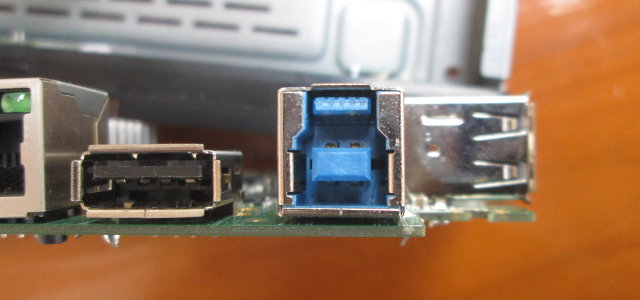 It turned out this is a USB 3.0 Standard-B receptacle. As my knowledge about USB 3.0 connectors was obviously lacking, I’ve decided to investigate and have a look at the different existing and upcoming USB 3.0 connectors that we should find in different types of devices and computers now or very soon.
It turned out this is a USB 3.0 Standard-B receptacle. As my knowledge about USB 3.0 connectors was obviously lacking, I’ve decided to investigate and have a look at the different existing and upcoming USB 3.0 connectors that we should find in different types of devices and computers now or very soon.
Standard-A USB 3.0 connectors and receptacles
This is the easy one, it looks very similar to the USB 2.0 connectors, except it’s blue and adds 5 pins for USB 3.0 connectivity. It’s backward compatible with USB 2.0, and the receptacle is used for hosts. Most people must have already seen that one.
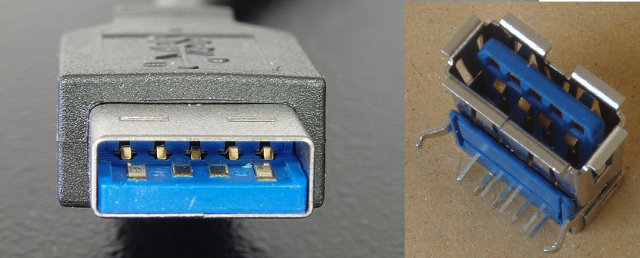
Standard-B USB 3.0 connectors and receptacles
USB 3.0 Standard-B receptacles and connectors are somewhat similar to the USB 2.0 version, but are larger, and with one extra row for USB 3.0 connectivity. Such receptacle accepts either a USB 3.0 Standard-B plug or a USB 2.0 Standard-B plug, and it’s also backward compatible with USB 2.0. Due to different size, a USB 3.0 Standard-B connector can’t be plug into a USB 2.0 Standard-B receptacle. The Standard-B receptacle is used for USB devices. If you have a USB 3.0 device (e.g. USB hard drive) you must have already seen this, but since I don’t have ny it was my first time to see this type of connector.
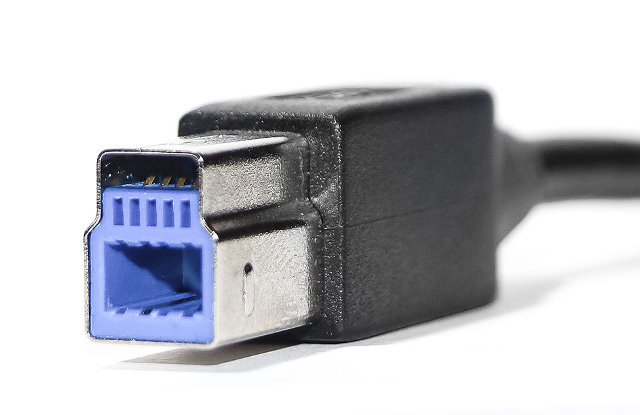
Micro-A USB3.0 receptacle and Micro-B USB 3.0 connectors
The USB 3.0 Micro-B cable plug consists of a standard Micro-B USB plug, with an additional 5-pin plug place on the other side. That’s been done this way for USB 3.0 Micro-A host connectors to preserved compatibility with USB 1.x/2.0 Micro USB cables. There’s no way to connect a micro USB 3.0 cable into a micro USB 2.0 receptacle due to obvious mechanical differences. I understand these types of connectors and receptacles can’t be found in many devices just yet, Samsung Galaxy Note 3 being an example, but many mobile devices may eventually feature micro-B USB 3.0 receptacles.
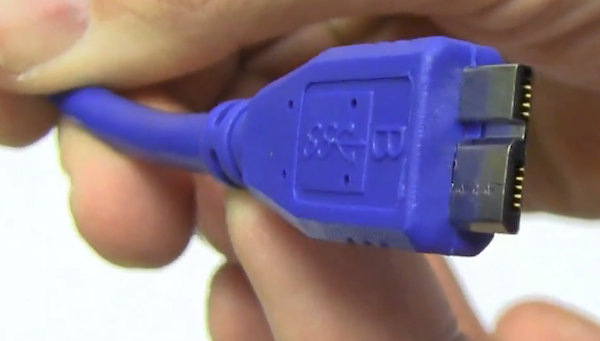
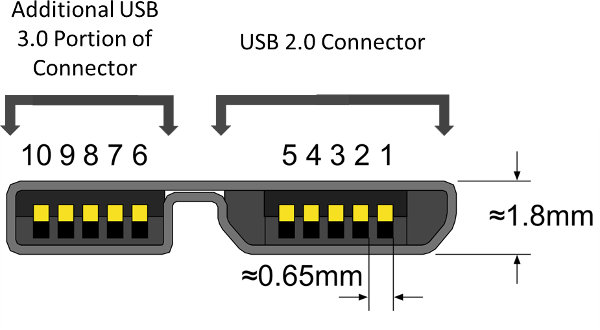 USB 3.0 Type-C
USB 3.0 Type-C
There’s a new type of USB 3.0 connector coming up announced last December. I could not find pictures yet, but we do know this new connector will be about the size of USB 2.0 Micro-B, it will be reversible (“users will no longer need to be concerned with plug orientation/cable direction”), support scalable power charging, and USB 3.1 Superspeed+. Since many people do not really like USB 3.0 Micro-B, USB Type-C connectors may even replace the latter in mobile devices such as tablets and smartphones.
USB 3.0 Signals
USB 2.0 has 4 signals: Ground, Power (5V), and D-/D+ differential pair for data. There’s also the shield provided by the metal housing. USB 3.0 is backward compatible but adds Superspeed transmitter and receiver differential pairs (4-pin), and ground for signal return. According to the table below, there are also some “Powered-B” with 2 extra pins for power and ground provided by the device.
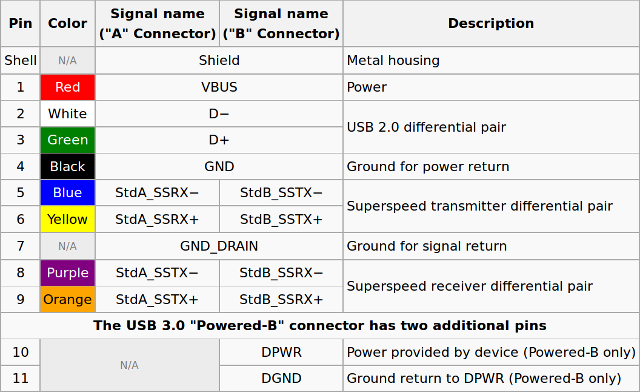
Source: Mostly Wikipedia

Jean-Luc started CNX Software in 2010 as a part-time endeavor, before quitting his job as a software engineering manager, and starting to write daily news, and reviews full time later in 2011.
Support CNX Software! Donate via cryptocurrencies, become a Patron on Patreon, or purchase goods on Amazon or Aliexpress





Hopefully the USB Type-C connector will be sturdier than the USB 2.0 Micro-[a|b|ab] connector, and as it is pretty much an clone of Apple’s Lightning port connector, it should be pretty much fool-proof. 😉
And of course become the next de-facto standard for charging and host/device (OTG) functionality (too bad not including Displayport signaling for DisplayDock support)… EU better update their standard(s) demands.
Just too bad it will take another painful transition between different cables, just like the mess with Mini and Micro changes. 🙁
@anon
> Just too bad it will take another painful transition
So, maybe EU won’t update their demands for USB3 bloat, and will pass other demands, like that a device boasting USB2 support should offer end-user speed of 480Mbit/s +/- 20%. Oh, that would be quite an innovation kick-in-ass for the lazy hardware crowd.
The type A are incredibly flimsy, I’ve seen the connectors break off from the PCB on some devices.
For some insane reason USB hard drives continue to use type A even when type B would be no problem to use.
Hopefully type C fixes the problem.
the USB3 micro B connect on the side labelled usb 2.0 looks like a micro USB2 could you connect with a micro usb cable .. (at usb2 speeds)
@Rand
Yes, a micro-A USB3 connector will accept a micro-B USB 2 plug.
Pictures of USB 3.1 Type C reversible cable – http://www.theverge.com/2014/4/2/5573680/first-images-of-the-reversible-usb-cable
Reversible Type C specification released (http://www.usb.org/press/USB_Type-C_Specification_Announcement_Final.pdf)
Key characteristics of the USB Type-C connector include:
• Entirely new design
o Tailored for emerging product designs
o Robust enough for laptops and tablets; slim enough
for mobile phones
o Similar to size of USB 2.0 Micro-B
•Usability enhancements
o Reversible plug orientation and cable direction
•Supports scalable power charging
•Future scalability
o Designed to support future USB performance needs
•Mechanical specs:
o Receptacle opening: ~8.4mm x ~2.6mm
o Durability: 10,000 cycles
o Improved EMI- and RFI-mitigation features
o Power delivery capacity: 3A for standard cables and 5A for connectors
That article is also interesting: http://www.embedded.com/design/connectivity/4437961/USB-3-0-vs-USB-2-0–A-quick-reference-summary-for-the-busy-engineer?_mc=sm_emb
Hello guys, mi external hdd 3.0 B has its 2.0 side dead, not broken , could i bridge the data lines to the 3.0 side of the conector??
Thanks.
@PLAYER 1
It might be feasible since USB 3.0 is compatible with USB 2.0, and you can see the USB 2.0 signal in the table in the post above.
But why don’t you just connect the USB 3.0 port to the USB 2.0 port of your computer / device with a USB cable?
If you have a 3.0 “only” device like i mentioned above, it wont comunicate with a 2.0 only input in any way, cause that device is not sending any 2.0 signal via 2.0 pins. Tested.
You know that 3.0 and 2.0 data channels are different and dont share any point of hardware after the data processor.
But i suppose the data is still present on both “hardwares”, so …
The only possible way i imagine to solve that question is to try a bridge of data chanels.
The other possibility is: if 3.0 side doesnt detect a 3.0 input it could shoot down that part of the output and continue sending data via 2.0 side…
Ill try it for sure when i have a time
Ill be back…
Thanks.
(sorry for my bad english, i speak spanish)